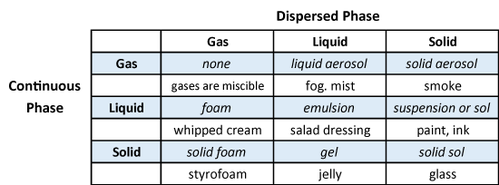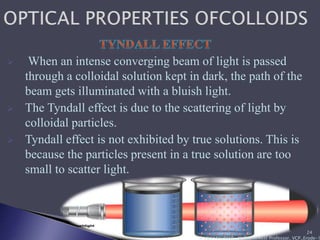how is paint made that it can be classified as a colloid
The colloid particles are repelled by water. For example a motor car paint can enhance the appearance of the car body by providing color and gloss and it also protects the car body from corrosion.
What Are The Properties Of Solutions Suspensions And Colloids Quora
Paint is a colloid due to being dispersed and mixed with a couple different substances.

. The colloid particles are attracted to the water. Colloids refer to dispersions of small particles usually with linear dimensions from around 1 nm to 10 micrometres. These are the opposite in nature to hydrophilic colloids.
Based on the nature of the interaction between the dispersion medium and the dispersed phase colloids can be classified into lyophilic and lyophobic. The author is a well-known scientist in this field with a long experience in colloid science Henkel KGaA Dusseldorf Germany Dr. Colloid solutions can be classified into three.
The foam in this set is created by capturing the gas in a liquid. Examples include Agar gelatin pectin etc. Colloidal sulphur can be obtained by passing oxygen gas through a solution of hydrogen sulphides.
Paint is a colloid with the pigment as the dispersed phase and the paint base as the continuous phase Characteristics of Colloids Colloids are unique from other mixtures such as suspensions and. Although it is a more expensive way to manufacture it is still the way we make our coatings today. When we make gelatin such as Jell-O we are making a type of colloid Figure 9.
The substances which are dispersed would be the gas triggering the fluid to become frothy and. When the paint stirs slowly tiny pigment particles become suspended and spread evenly all over the liquid. Thus even if the dispersed phase is separated from the.
The pigment is added to the resulting liquid of the solvent and binding. Tadros is well-known in the field of colloid science. Described in detail in Chapter 3 and colloid stability lack of aggregation is dis-cussed in Chapter 4.
Emulsion is the mixture of liquids it is like if one liquid is constantly dispersed all through another liquidAn example of this would be mayonnaise or milk. Colloids can be made in two different methods. When paints are manufactured the pigments are very finely ground often with the binder to create a particle size that is colloidal.
A solution of arsenic sulphide is obtained in this method. See answer 1 Best Answer. Mixture vs pure substance.
See answer 1 Best Answer. There are no definite boundaries between the substance and the surrounding media. How is paint made that it can be classified as a colloid.
2H 2 S O 2 2H 2 O 2S Sulphur sol b By double decomposition. These are water-loving colloids. Gelatin sets on cooling because the hot aqueous mixture of gelatin coagulates as it cools and the whole mass including the liquid sets to an extremely viscous body known as a gel a colloid in which the dispersing medium is a solid and the dispersed phase is a.
By precipitation condensation or redox processes small dispersed molecules. The actual Colloid process that was used by Western Colloid over 40 years ago was a manufacturing technique that ensured a perfect blend of the different ingredients in a coating product. These particles may be either dissolved macromolecules or having macromolecular structures formed from smaller structural units or they may constitute a separate phase as in aerosols powders pigments dispersions emulsions or even finely.
The words lyo and philic mean liquid and loving respectively. In this method any oxidising agent like HNO 3 H 3 Br 2 can also be used. As a consequence these substances are called paints or dyes.
They are also known as reversible sols. Milling spraying or the use of shear disperses big particles or droplets to colloidal size eg shaking mixing or high shear mixing. We consider that process a key component to the longevity.
Dried paint is typically considered to be a colloid as the dispersed particles are indefinitely spread throughout the binder dispersing medium. The term colloidfrom the Greek words kolla meaning glue and eidos meaning likewas first used in 1861 by Thomas Graham to classify mixtures such as starch in water and gelatinMany colloidal particles are aggregates of hundreds or thousands of molecules but others such as proteins and polymer molecules consist of a single extremely large molecule. High quality can be expected University of Bayreuth Germany Professor Tadros is a well-known expert on the topic.
If the dispersed phase has an affinity for the dispersion medium the colloid is called a lyophilic colloid. When considering a paint formulation one must know the specific interaction. This uniform dispersion of pigments is called a colloid.

What Is A Colloidal Solution Introduction Colloid Types Video Example

Introduction To The Colloid Chemistry And Surface Phenomena

Introduction To The Colloid Chemistry And Surface Phenomena

Lesson Explainer Colloids And Suspensions Nagwa

What Is A Colloidal Solution Introduction Colloid Types Video Example

Is Paint A Colloid Techiescientist

Is Paint A Colloid Techiescientist

Types Of Colloids And Examples Of Colloids Youtube

Colloids And Particle Characterization
Lesson 9 Colloids And Coagulation

Introduction To The Colloid Chemistry And Surface Phenomena

Examples Of Colloids Notes Study Chemistry For Jee Jee

Is Paint A Colloid Techiescientist
What Are Colloidal Substances Quora

Types Of Colloids Overview Examples What Is Colloidal Dispersion Video Lesson Transcript Study Com



